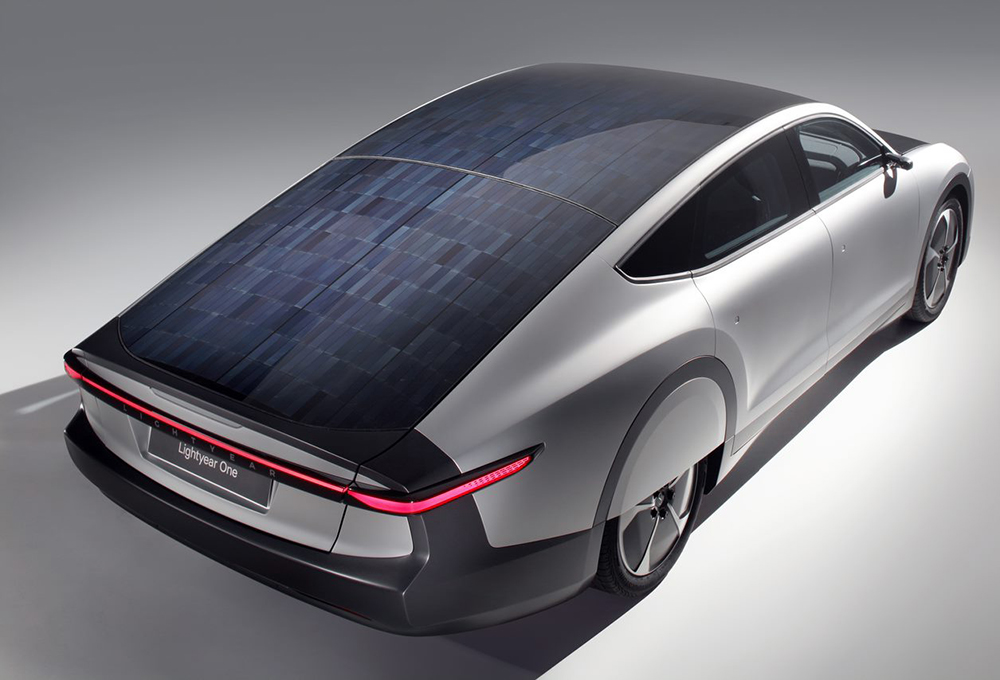According to its developers, solar cells untether the Lightyear One from the grid. (Lightyear)
This EV’s design features enough sky-facing surface area to place about 1,000 individual photovoltaic cells.
It’s been more than a decade since Toyota first developed a photovoltaic system for the roof of a Prius hybrid-electric vehicle (HEV). Those solar cells, available on Japan-based models around 2010, had a peak capacity of 50 watts – generating only enough power to run auxiliary devices such as a ventilation fan. Further development for the past 10 years by Toyota, as well as Hyundai, Nissan and Tesla, opened the possibility of a vehicle’s rooftop solar charging an electric vehicle’s (EV’s) batteries, adding maybe a few miles of range when the vehicle is left in the blazing sun for a several hours.
Those efforts were baby steps compared to Lightyear One, the ground-up, “solar EV” created by Lightyear, the startup based in Helmond, Netherlands. The company was founded in late 2016 by five former University of Eindhoven engineering students. They were part of the team that won the 1,800-mile (2897-km) World Solar Challenge race in 2013 and 2015. The company now has 120 employees, including former staff from Ferrari, Jaguar Land Rover, and Tesla.
The design of the Lightyear One, the company’s inaugural $165,000 model, was penned by Lowie Vermeersch, the former Pininfarina designer who directed the shape of the Ferrari 458 Italia and Maserati Birdcage 75th, among others. FEV, the engineering firm based in Aachen, Germany, helped develop the Lightyear One’s 60-kWh battery system; additionally, the company has received more than $33 million in investments, vehicle reservations and grants.
Up to 45 sun-powered miles
What distinguishes the Lightyear One from previous solar-car efforts is the company’s clean-sheet, systems-engineered approach. “You need to start with a blank sheet of paper at the platform level,” said Arjo van der Ham, Lightyears’s chief technology officer. For Lightyear, that meant four propulsion motors (one at each wheel), ultra-lightweight materials and cutting-edge aerodynamics with a Cd. of less than 0.2. The design also features enough sky-facing surface area to place about 1,000 individual photovoltaic (PV) cells crafted from production SunPower Maxeon cells.
“The cells are cut to increase surface ratio, facilitate curvature and increase the efficiency of the electronics,” said van der Ham. Each cell measures about 1 in. X 4 in. (25 mm X 102 mm). A few dozen micro-inverters are integrated into the vehicle’s carbon-fiber structural beams. The micro-inverters allow Lightyear to derive solid voltage from the cells arranged in series while maintaining a balanced flow of power even if some cells get uneven light. Total peak output is 1.25 kW – enough power to add about 20 miles (32 km) of average range per day. “On a good day, you’ll get 45 miles,” said Lex Hoefsloot, chief executive at Lightyear.
Eric Wesoff, editor of Berlin-based PV magazine, questioned the high cost of expensive solar cells and the challenge of mounting them on a car. “PV cells don’t like heat. Heat reduces output and a car roof is a hot place,” said Wesoff. He added that dirt and partial shading are “not solar’s friend.” These challenges are acknowledged by van der Ham. But he said Lightyear incorporates those “expected losses” into account. “Also, we have electronics that minimize the losses due to the ‘weakest link in the chain’ effect,” he said, referring to the micro-inverters.
Again, the team takes a systems approach to balance competing design goals. “You want a car that’s as narrow and flat as possible for aerodynamics,” said Heofsloot. But you also want the broadest area for the PV cells and a “seating position that’s as comfortable as possible,” he added.
Long-term goal: a comfortable, self-charging car
We sat in the Lightyear One when the team visited San Francisco in late 2019. The vehicle was reasonably spacious. The design forgoes a “frunk,” instead using that space to house an HVAC module. The company is not yet granting rides in the car, its single prototype. There also are tradeoffs related to the vehicle’s battery size, which now grants an estimated 440 miles (708 km) on a single charge (including sun-derived energy). “If you increase the battery size, the weight increases, so then the motors have to increase in weight,” said Heofsloot. He said this created a “spiral-up effect.”
High efficiency and slippery aerodynamics allowed Lightyear to use relatively small, 20-kW, in-wheel motors. Hoefsloot believes the team solved issues related to unsprung weight and durability by integrating the motors with the suspension. “People say they want a car to charge itself,” said Hoefsloot. “Therefore, I think it’s the end game of where we’re heading with electric cars.” He believes that other manufacturers will begin using Lightyear One’s architecture. The company aims to produce 946 vehicles – a lightyear measures 9.46 trillion kilometers – starting in 2021. It’s projects a ramp-up to 100,000 vehicles annually as early as 2023.
Source: https://www.sae.org
CUT COTS OF THE FLEET WITH OUR AUDIT PROGRAM
The audit is a key tool to know the overall status and provide the analysis, the assessment, the advice, the suggestions and the actions to take in order to cut costs and increase the efficiency and efficacy of the fleet. We propose the following fleet management audit.




